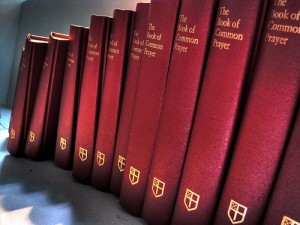From the Psalter:
Seven times a day do I praise you, because of your righteous judgments.
(From the Daily Office Lectionary – Psalm 119:164 (BCP Version) – July, 2013.)
 The Book of Acts, the earliest church history, tells us that the followers of Jesus practiced daily prayer: “Day by day, as they spent much time together in the temple, they broke bread at home and ate their food with glad and generous hearts.” (Acts 2:46) Eventually, the Christians were excluded from Jewish worship assemblies, either by their own choice or by action of the authorities, and in an unrelated development, the Temple was destroyed in 70 AD. Where, then, did Christians pray together? Or, for that matter, alone?
The Book of Acts, the earliest church history, tells us that the followers of Jesus practiced daily prayer: “Day by day, as they spent much time together in the temple, they broke bread at home and ate their food with glad and generous hearts.” (Acts 2:46) Eventually, the Christians were excluded from Jewish worship assemblies, either by their own choice or by action of the authorities, and in an unrelated development, the Temple was destroyed in 70 AD. Where, then, did Christians pray together? Or, for that matter, alone?
It is likely that there were ascetics who sought solitude away from the cities and what they perceived as a sinful society around them from the start of the Christian community. They may have emulated John the Baptizer and his followers, the Jewish Essenes, or other esoteric communities. However, the first historically verifiable hermit (or “anchorite”) seems to be St. Anthony of Egypt. Unfortunately for him, others were attracted to his lifestyle and he found himself surrounded by disciples following his example. During Anthony’s lifetime, one of his followers, St. Pachomius established the first community for ascetics living together, “cenobites,” during the early part of the Fourth Century. By the end of the Fifth Century, these monks had developed the practice of gathering together for prayer and the early outlines of a Liturgy of the Hours composed of seven “offices” had emerged. It is possible that number of services was chosen because of this (and similar) verses in Scripture.
The foundation of modern western monasticism was the Rule of St. Benedict, authored by Benedict of Nursia in the 6th century. As part of his design for monks living in community, he adopted the practice of regular hours of prayer, adding an eighth. The eight monastic hours are the following:
- Matins (during the night, usually at midnight; sometimes called Nocturns)
- Lauds (at dawn, or 3 a.m.)
- Prime (approximately 6 a.m.; this is the hour added by Benedict)
- Terce (approximately 9 a.m.)
- Sext (approximately 12 noon)
- None (approximately 3 p.m.)
- Vespers (approximately 6 p.m., “at the lighting of the lamps”)
- Compline (approximately 9 p.m., before retiring)
Archbishop Thomas Cranmer, the genius behind the Anglican Prayer Book tradition, took bits and pieces of these monastic hours to create the offices of Daily Morning Prayer and Daily Evening Prayer included in The Book of Common Prayer of 1549 and in every revision of the Prayer Book since. It was Cranmer’s idea that individuals and families, like monks in community, would say these offices every day, coming together with others on Sundays to celebrate the Holy Communion.
It was, I’m afraid, a wonderful but never realized vision; I doubt very seriously that there has ever been a time since the Reformation when Anglicans, in general, stop during their days for even a single instance of regular, corporate, liturgical prayer, let alone twice a day, let alone seven or eight times a day. Nonetheless, the Anglican ethos is one of constant daily prayer deriving from the Scriptural witness of the Psalms.
It is my practice to say the Daily Offices at morning and evening and, occasionally, Compline before retiring. The current American Prayer Book of 1979 includes two forms of Morning Prayer, an office for Noonday Prayer, two forms of Evening Prayer, an order for Compline, and four short forms for individual prayer throughout the day. Our tradition is steeped in the monastic tradition!
But how many of us can say this verse of Psalm 119 with complete authenticity? I know that I can’t! Two times a day? Usually. Seven times a day? It just doesn’t happen! It probably should, but it doesn’t.
====================
A request to my readers: I’m trying to build the readership of this blog and I’d very much appreciate your help in doing so. If you find something here that is of value, please share it with others. If you are on Facebook, “like” the posts on your page so others can see them. If you are following me on Twitter, please “retweet” the notices of these meditations. If you have a blog of your own, please include mine in your links (a favor I will gladly reciprocate). Many thanks!
====================
Father Funston is the rector of St. Paul’s Episcopal Church, Medina, Ohio.



Leave a Reply